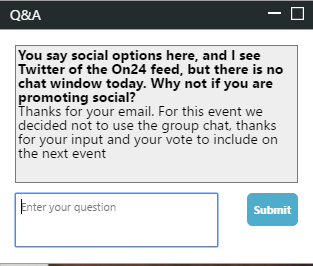There must be some really compelling reasons to switch off the chat section in your webinars, as so many that I’ve attended recently don’t have this active.
Reasons for removing webinar chat functionality:
Stretching my imagination a bit, they could be…
- Focus on the content delivery
- Reduce distractions for attendees
- Avoid over taxing the speaker
- Ensure competitors attending the session don’t see each other
- People will see how few attendees there are on the webinar
- Avoid negative comments or questions
- Use the Question panel direct to host/producer/moderator
- It doesn’t exist in the software (such as GoToWebinar)
Are there other’s you could add? Comment below if there are.
Are these legitimate reasons? Really?
From my tone so far you have probably picked up that I don’t think so.
- Focus on the content deliveryI focus better on the content when I’m discussing it with other attendees and the speaker(s). I can share my own ideas, thoughts, research and resources and look forward to other people doing the same so I can have broader and deeper learning.
- Reduce distractions for attendeesIt doesn’t reduce distractions, as I’m actually MORE distracted. Probably the speaker isn’t the most amazing in the world, and therefore I’m more likely to put the webinar on a second monitor and start ploughing through email, or pick up my phone and load Twitter.
Using chat is me ENGAGING with the content, not being distracted! - Avoid over taxing the speakerMaybe you should select a speaker that can handle the chat window. Or you team them up with a host/producer/moderator that can handle that for them. This role is typing in the chat too and bringing comments and questions to the attention of the speaker at pre-decided points.

- Ensure competitors attending the session don’t see each otherYep, competitors or clients in different industries might be a challenge to deal with. If people are logging in with their real names, that’s only an issue if they might know each other. When is this a negative? Perhaps when you have two strong competitors both your clients. Then perhaps offer two webinars, promote one to one company, one to another?
Some software allows you to keep the attendees separate but still include the chat, though this usually does include names. If that’s an issue, some software allows you to set the format, such as first name only, or perhaps suggest to your attendees a protocol in your pre-information.
Perhaps more transparency is a better thing. - People will see how few attendees there are on the webinarFew attendees on a webinar is not a failure. It’s a huge strength for the attendee and the conversation or learning points as you get to have much better, in-depth conversation. If this is an issue, you need to address your approach, expectations or marketing.

- Avoid negative comments or questionsPeople will make negative comments and ask awkward questions one way or another. If it’s not the webinar, it might be on your Facebook page, or Twitter including your @handle. Why not get it out and deal with it?
If you have a marketing webinar, this is about objection handling. If it’s about service and products then at least you have feedback for improvement. If you are worried about what other potential clients will think, it’s probably how you handle the comments and questions that will make the difference.
If you do have a rogue attendee really bent on making an issue, and you’ve attempted dealing with it politely in the chat and offered to take it offline to deal with and they are persisting, then perhaps removing that person from the session is the best thing to do. But this doesn’t penalise everyone else! - Use the Question panel direct to host/producer/moderatorQuestion or Q&A panels or pods are brilliant to separate out questions from a busy chat window. This makes it much more manageable for a speaker on their own and if there is a moderator/host/producer, who can deal with that. Sometimes there can be a few people to deal with a busy Question area and reply direct or to all attendees.
That said, I’ve been on a number of webinars the last couple of weeks where there has been ONLY a question pod.This is a great example of the question not being answered properly on a webinar I’m attending whilst writing this blog post (yep, because there was no chat, no tweets and it was a boring webinar). The speaker said that webinars should be social. So I asked this:
It would have been nice if they actually answered the question. Or, am I being mean?
On other webinars recently I’ve asked questions pertinent to the beginning of the session (such as, “is there a Twitter hashtag for this webinar?”) received no response. If there’s no verbal, private written or public written answers to the questions, what’s the point of entering them?
- It doesn’t exist in the software (such as GoToWebinar) Get better software.
Read more on chat with this blog:
Disabling webinar chat – what your audience really thinks



Thank you for this comprehensive review on chat on webinars Jo. As a relative newbie to webinars I can safely say I love chat on webinars it allows engagement and I feel I have a part to play and share ideas and get advice from other candidates. I do not get distracted…without chat I would get bored being talked at (back at school in the 70s and 80s) and would look at emails and phones. Webinars with chat can be even better (and this is something I never thought I would day!! ) than a good ftf facilitated workshop!!! Poor answer from company btw!!!!
Great post Jo! It’s astonishing how often there isn’t chat. But at least it means I can switch off a bit and paint my nails instead of paying full attention 🙂
Haha well it’s about having the right learning intervention for what you need to achieve at that time, and if it’s painting your nails, then that’s all well and good 😀